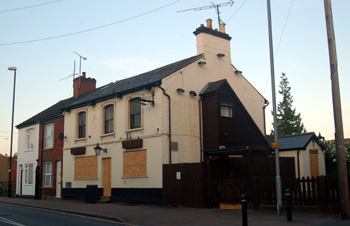The White Hart Inn Leighton Buzzard

The site of the White Hart June 2008
The White Hart Inn: 87 North Street, Leighton Buzzard
The Manor of Leighton Buzzard alias Grovebury was the principal landowner in the town before the 19th century. Bedfordshire & Luton Archives & Records Service has a full run of court rolls from 1393 to 1727 [KK619-715] and another full run from 1704 to 1867 [X288/1-23]. The service also has court rolls for other manor to own land in the town, the Prebendal Manor, from 1448 to 1459, 1588 to 1591, 1611 to 1622, 1627 and 1631 [KK792-1798]. Detailed study of these would be bound to produce quite full histories for most licensed premises in the town. Unfortunately such study would take a very long time. Thus the histories of licensed premises in these web pages are quite summary and not necessarily the full story.
The earliest mention so far found for the White Hart is in 1713 when Joyce Foster, who also owned the Red Lion, devised it in her will to her kinswoman Mary Andrewes [RY543]. The will was proved in 1722 and Mary Andrewes duly admitted to the copyhold premises at the manorial court [RY544]. She surrendered it to the uses of her will in 1726 [RY545]. In 1749 Joyce Steven was admitted to the inn on Mary Andrewes' death [RY546]
Bedfordshire & Luton Archives & Records Service has a formulary and notebook kept by 18th century attorney Benjamin Pyne which contains a list of twelve licensed properties in the town in 1761. Each inn also has a name beside it which appears to be the name of the licensee (who may both, of course, also have been the owner in some cases). The White Hart is linked with the name of Richard Bigg who was certainly just the licensee.
In 1791 Joyce Steven sold the White Hart to William Johnson[ RY546] who was duly admitted [X288/9]. In the Northampton Mercury of 19th January 1793 licensee of the White Hart, Caleb Grimshaw, subscribed to a resolution of Leighton Buzzard publicans banning "seditious and disaffected persons" from their houses. This presumably was in reaction to the events across the Channel in France (four days previously King Louis XVI had been sentenced to death and two days later he went to the guillotine).
No more is heard of the White Hart. In 1808 William Johnson, son of the man who bought it from Joyce Steven enfeoffed the northern half of a cottage formerly called the White Hart to William Smith. He had obviously enfranchised the copyhold cottage, turning it into freehold. At the time of writing [2009] the former White Lion public house stands on the site.
References:
- RY543: devised: 1713, proved 1722;
- RY544: admission: 1722;
- RY545: surrender: 1726;
- RY546 and X288/5: admission: 1749;
- X171/206: landlord named: 1761;
- RY546: sale: 1791;
- X288/9: admission: 1791;
- Northampton Mercury: resolution of Leighton Buzzard publicans banning "seditious and disaffected persons" from their houses: 19 Jan 1793;
- WL1000/1/LB2/1: feoffment from William Jackson to William Smith of north end of cottage formerly called White Hart: 1808
List of Licensees: note that this is not a complete list; entries in italics refer to licensees where either beginning or end, or both, dates are not known:
1713-1720: Humphrey Vesey;
1750-1751: Edmund Dawson;
1761: Richard Bigg;
1791-1793: Caleb Grimshaw